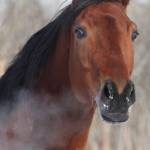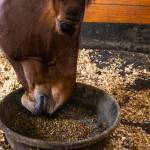Winter Horse Management and Riding Considerations

Even if you don’t have an indoor arena, there’s no reason you have to give up all riding in the winter. In fact, riding your horse along a snowy trail on a cold but sunny winter day can be lots of fun. Winter riding, however, requires a little thought and preparation to keep it safe for you and your horse.
Hoof care. Your horse’s hooves grow more slowly in the cold months, but they don’t stop growing completely, so you should keep a schedule of regular trimmings. If your horse is shod, he still needs to have his shoes reset every four to six weeks. Ask your farrier about snow pads to keep snow from balling up in the hooves, and borium patches on the horseshoes to prevent slipping on ice or pavement. For horses that need a higher level of hoof-related nutrients in their diet, Kentucky Equine Research offers Bio-Bloom PS (Bio-Bloom HF in Australia) to provide additional support for hoof quality and growth.
Clipping. Your horse’s heavy winter coat is designed to keep him warm and dry during the winter season. If you’re going to be doing only light riding, there’s no reason to clip your horse. Heavy work, however, will make your horse sweat, and it will take a long time for his coat to dry. Turning a sweaty horse out into cold, wet, or windy weather is asking for trouble. By clipping away patches of long hair, you can avoid the problems associated with sweating. Various clipping patterns can be used depending on the horse’s discipline and how hard he will be worked. However, a clipped horse will need to be blanketed when he’s not being ridden because his shorter coat won’t protect him from the weather.
Tack. For a short walk around the pasture, try a bareback ride if you and your horse are comfortable doing this. Riding bareback will keep the rider warmer than using a saddle. Keep in mind, however, that chilly winter weather and a brisk wind can make even a calm horse feel friskier than usual. Shying, bucking, and bolting are ways that some horses show how good they are feeling, and the rider needs to be ready to deal with these behaviors. Use a saddle for more security if your horse is young, jumpy, or new to you.
Some riders use a quarter sheet when they ride in the winter. This small blanket covers the horse’s back behind the saddle and hindquarters, helping to keep his muscles warm. Don’t just throw one of these on your horse and head to the ring, however. The first time the quarter sheet flaps in the breeze, your horse will probably react. Accustom him to the weight, feel, sound, and sight of the quarter sheet by walking or longeing him several times with it on before you ride.
Finally, take the time to warm the horse’s bit in your hand, a bucket of warm water, or a commercial bit-warming device before you ask the horse to take it into his mouth. He’ll appreciate your consideration.
Barn. Though it’s listed last in this article, a barn or shelter is an important part of your winter management plan. Barns or run-in shelters should provide horses a dry place to get out of the wind, but they should not be airtight. Cold temperatures won’t bother horses that are healthy and in acceptable body condition, and barns that allow good air circulation will go a long way toward preventing respiratory ailments caused by ammonia fumes, dust, and molds.
Under normal circumstances, healthy horses should not be kept in heated barns. Going out of a heated barn into a cold riding arena shocks the tissues in a horse’s (and a human’s) respiratory tract, and coming into a heated barn after work slows the normal process of cooling down.








